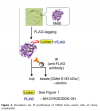STAT5 Inhibitors and Regulatory Mechanism
In the field of life science research, the family of Signal Transducers and Activators of Transcription (STAT) has always been a focus of scientific attention. This family, especially the STAT5 subtype, has garnered significant attention in recent years due to its abnormal activation in various cancers. STAT5, as an important member of the STAT family, is primarily activated by membrane receptor-associated Janus kinases (JAK) in response to numerous extracellular signaling molecules, thereby playing crucial roles in cell immunity, proliferation, apoptosis, and differentiation. There are two subtypes of STAT5: STAT5A and STAT5B. While they have structural and functional similarities, their roles in specific physiological processes and diseases have subtle differences. This article will delve into STAT5 inhibitors and their regulatory mechanisms, reveal the differences between STAT5A and STAT5B in different indications, and showcase Glpbio's forefront contributions in this field.
STAT5 Inhibitors and Their Regulatory Mechanisms
STAT5 inhibitors are cell-permeable compounds targeting the abnormal activation of the STAT5 pathway. These inhibitors exert their regulatory mechanisms through various pathways to inhibit the growth, proliferation, and survival of cancer cells.
First, STAT5 inhibitors can inhibit the phosphorylation of STAT5. Normally, the activation of STAT5 accompanies tyrosine phosphorylation, which further leads to the dimerization of STAT5. STAT5 inhibitors directly inhibit this process, effectively blocking the activation of STAT5 and thus its signal transmission.
Secondly, STAT5 inhibitors can prevent the dimerization of STAT5. Dimerization is a critical step after STAT5 activation, allowing STAT5 to translocate to the cell nucleus and exert its transcriptional activation ability. STAT5 inhibitors interfere with the interaction between STAT5 molecules, effectively preventing dimerization and thus blocking its signal transmission.
Additionally, STAT5 inhibitors can inhibit the binding of STAT5 to DNA. By binding to specific gene promoter regions, STAT5 can activate the transcription of associated genes. STAT5 inhibitors block this binding process, effectively inhibiting the transcriptional activation ability of STAT5, thereby inhibiting cancer cell growth and proliferation.
Lastly, STAT5 inhibitors can also target upstream signaling pathways. In some cases, the activation of STAT5 is driven by the activation of its upstream signaling pathways such as the JAK family kinases. STAT5 inhibitors suppress these upstream signaling molecules, indirectly reducing the activation level of STAT5, thus achieving a dual inhibition of the STAT5 pathway.
In conclusion, the regulatory mechanisms of STAT5 inhibitors involve multiple pathways, including inhibiting phosphorylation, preventing dimerization, blocking DNA binding, and targeting upstream signaling pathways. These mechanisms work together to provide new insights and possibilities for cancer treatment.
STAT5A and STAT5B: Subtle Differences in Functions and Indications
Although STAT5A and STAT5B have high structural and functional similarity, their roles in specific physiological processes and diseases have subtle differences. These differences provide important information for disease-specific treatment strategies.
In the indication of breast cancer, STAT5A may have a more significant role. Studies indicate that the activation of STAT5A is associated with a good prognosis in breast cancer patients. STAT5A inhibitors are expected to inhibit the growth and invasion of breast cancer cells. In contrast, the role of STAT5B in breast cancer is unclear, providing a theoretical basis for the development of specific inhibitors targeting STAT5A.
In the field of hematologic malignancies, STAT5B may have a stronger association. Research finds that the activation of STAT5B is related to the malignancy of hematologic cancers such as chronic myeloid leukemia (CML) and acute myeloid leukemia (AML). STAT5B inhibitors are expected to provide new options for the treatment of these hematologic malignancies. Although STAT5A also plays a role in some hematologic malignancies, its association is relatively weaker.
Moreover, in growth hormone-related diseases, STAT5B plays a crucial role. It has a more direct association with growth development disorders such as growth hormone deficiency and growth hormone resistance. This provides potential application value for treatment strategies targeting STAT5B. In comparison, STAT5A's role in the growth hormone signaling pathway might be relatively minor.
Glpbio: Committed to the Development and Innovation of STAT5 Inhibitors
As one of the world's leading suppliers of high-performance life science products, Glpbio has made significant contributions to the development and innovation of STAT5 inhibitors. The company covers 20 popular research fields including cancer, neuroscience, anti-infection, and epigenetics, offering over 20,000 life science research reagents, including chemical small molecules and peptides such as GPCR ligands, neurotransmitters, ion channels, and signal inhibitors.
In the STAT5 inhibitor field, Glpbio continuously expands its existing compound library to meet the latest research needs. The company is committed to providing inhibitor products with good purity, stability, and biological activity, offering comprehensive research materials and reliable product performance for biomedical research. Glpbio's core philosophy is to "ensure the quality of every product," which has led to widespread use of its products worldwide.
Glpbio's mission is to make it easier for global scientists to obtain the most innovative life science reagents, helping them achieve significant scientific discoveries faster. In the STAT5 inhibitor field, Glpbio's continuous effort and innovation provide new insights and possibilities for cancer treatment. The company's compounds are widely used in preclinical research of human diseases and have broad potential applications.
In summary, the research on STAT5 inhibitors and their regulatory mechanisms provides a new frontier for cancer treatment. The subtle differences between STAT5A and STAT5B in different indications provide crucial information for disease-specific treatment strategies. As a leading company in this field, Glpbio continuously devotes itself to the development and innovation of STAT5 inhibitors, providing the most innovative life science reagents to global scientists and jointly advancing the development of human health.












Comments